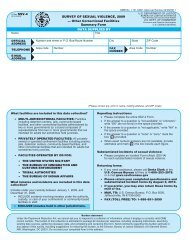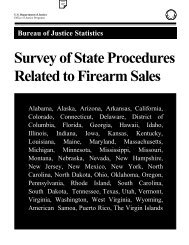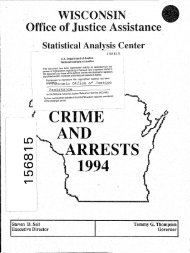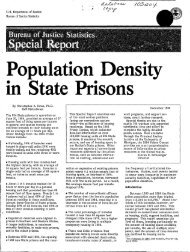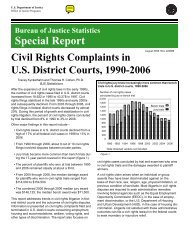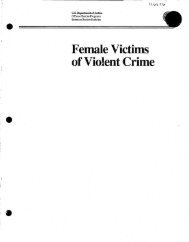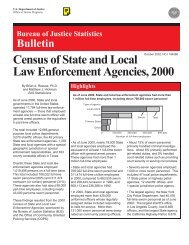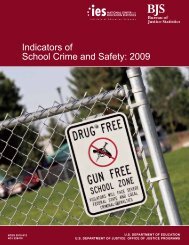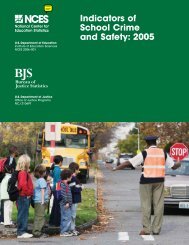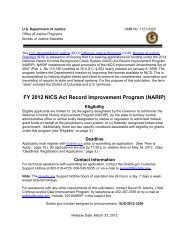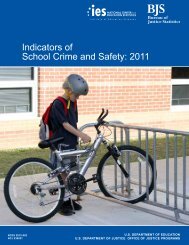~-~ - -~,..--- ------~----------------------~~~------------~, -' ,~.i<strong>Sourcebook</strong> <strong>of</strong> <strong>Criminal</strong> <strong>Justice</strong> <strong>Statistics</strong> <strong>1983</strong>Characteristics <strong>of</strong> the <strong>Criminal</strong> <strong>Justice</strong> SystemsTable 1.61 Volunteer programs In corr-ectional systems, by selected choracterlstlcs and jurisdiction, 1982--ContinuedVolunteerprogram inJurisdiction deportment Administered by whom?Rhode IslandSouth CarolinaSouth DakotaTennesseeUtahVirginiaWashingtonWisconsinWyomingGuamFederal <strong>Bureau</strong><strong>of</strong> ~(isonsYesYesYesYesYesYesYesYesN:>YesYesCentral Department <strong>of</strong> Corrections<strong>of</strong>fice with support fromstatewide comnission forvolunteer services.Each individual institution isresponsible for developing andcoordinating its own volunteerprogram. Central <strong>of</strong>fice maintainsagency record keeping anddisperses pertinent infotmt:!tion.Penitentiary.We have a State Director, 8regional coordinators, and ast<strong>of</strong>f person in each institutionassigned to volunteer services.Coordinated by central <strong>of</strong>fice;administered by individualsections.Central Deportment <strong>of</strong> Corrections<strong>of</strong>fice administers; however, ineach institution or agency branchutilizing volunteers, there is acoordinator who oversees the use<strong>of</strong> volunteers.There is a Comnunity Illvo!vementProgram at the central <strong>of</strong>fice todevelop policy, provide technicalassistance, and monitor facilityprograms, but primaryadministration tokes place atthe facility level.N:> central administration at thispoint, although it has beendiscussed. Programs are monitoredby eacn individual Institutionor unit. Although centralDepartmE:nt <strong>of</strong> Correctitlns doesnot sponsor or direct suchprograms, we do encourage andaccept a variety <strong>of</strong> volunteerprograms, and do monitor theiractivities.xCentral Deportment <strong>of</strong> Corrections<strong>of</strong>fice.Program administered by eachInstitution. An overall policystateroent governs theimplementation <strong>of</strong> the volunteerprograms.NJrnber <strong>of</strong>registered volunteersIn departmentHow ore volunteers recruited? 7 II /81-7 II /82Through use <strong>of</strong> statewidecomnission as well as newspaperods.~st approach the agency aboutinvolvement, such as churchgroups. We are just beginningto be active in recruitment <strong>of</strong>volunteers and \'.:>Iunteerservices. Each institutionrecruits to fill its own needs.From local, area and regionalchurches.Word <strong>of</strong> mouth, speakingengagements, advertisements, etc.(f)1,985Advertising, coordination with 1,027civic and religious groups.Approximately 70 percent arerecruited simply by word <strong>of</strong>mouth; no "shotgun" recruiting.Generally called "unpoid staff"rather than "volunteers." Allregular service volunteers have ajob description. Volunteerpositions are filled like poidst<strong>of</strong>f positions--have a specificneed, find right perse>n for thejob. Also utiliZe student internsthrough local universities.Most are from local religiousorganizations. Interns arerecruited from colleges anduniversities, some volunteersare recruited from serviceorganizations. A few programshove recT\liting flyers and usenewspoJjerli.(g)(h)Volunteer IJrganizations do 600 0own recruiting.xUsually referrals from the 4lkliverslty <strong>of</strong> Guam socialsc!~nces are receiVed.Often by Institutional chaplainsand speaking engagements.2,S:nXTypical volunteerduties and servicesVolunteer Court Aides, pre-releasetrainers, training academyconsultant, planners, studentinterns, other.Religious activities, AlcoholicsAnonymous, Individual and groupcOl.ln~eling, arts and cr<strong>of</strong>ts,one-to-one visitation program,comnunity group lectures.Rilgulor visits, lectures, attendI pecial events, appear at paroleh"arings, be present on dischargedol'!.Assume s~lective case loads,counseling, transporting clientsto appointments, etc. Onewell-established, well-receivedprogram is the ''Family HorneEvening Program."Tutors, religiOUS, one-to-oneadvocates, many more. Occasionalvolunteers include rock bondswho come in for one show, other"special event" people, someclergy people.Furlough sponsors, religiousservices, one-to-one guidedfriendships, Interns from paroleand probation are typical.Most activities focus onone-to-one counseling/support.xInitial Interviews, casepre§!mtgtlgns befgre comnlttees,research work.Marriage enrichment seminars,Bible study, religious services.bApproximate figure.d 100 indiViduals, plus 250 organizations.There were a to,tol <strong>of</strong> 255,616 volunteer hours put in during~Divislon <strong>of</strong> Prlsons--2,583; Division <strong>of</strong> Probatlon--2,400.flscal,!.ear 1982.N:> definite number, on average <strong>of</strong> 1,340 per month.• N.imbers are not compiled.Source: Contact, Inc., Corrections Compendium (Lillcoln, Neb.: Contact, Inc., April <strong>1983</strong>), pp. 6-11. Table adapted by SClLRCEBOO< st<strong>of</strong>f.Reprinted by permission.144Is orientationtraining requiredfor all volunteers?Yes; required orientation includesoverview <strong>of</strong> basic operations andgoals <strong>of</strong> department, securitymatters, familiarization withother department staff, areas <strong>of</strong>responsibility and lines <strong>of</strong>comnunicatlon.N:>; orientation is given to thoseWho are reQulllr volunteers.Special groups and events notgiven orientation.Yes; a series <strong>of</strong> orientationmeetings about the progran andguidelines before match is made.Yes; all volunteers must receiveat least 6 hours <strong>of</strong> trainingbefore certification.Yes; upon entering the correctionssystem, 01/ volunteers receiveorientation as to agency policiesand expectations.Yes; 01/ volunteers receiveorientation and training. Theintensity <strong>of</strong> the training dependliupon whether they are regularservice or one-time volunteers.Yes; It varies. Interns receivethe most extensive orientationand training on on ongoing basis.Some facilities have slidepresentations and handout <strong>of</strong>rules and regUlations.Yes; althcv.::,jh not yet formolizedall volunteers to institutions 'do receive some orientation;we do not provide training.XYes; given a complete briefinggn obJeGti\!es <strong>of</strong> correctiOi"iSand practical procedures.Yes; all recp.lve general overviewand familiarization, and morespecific orientation/trainingfor the duties they will perform.g4,023 regular service (on-going) volUnteers' 2 016 occ' IvolunWers. " aSlonoM?nthly averages: prlsons--I,600, adult probation and porole--50,work/t/,alnlng release--600-I,OOU.145
<strong>Sourcebook</strong> <strong>of</strong> <strong>Criminal</strong> <strong>Justice</strong> <strong>Statistics</strong> <strong>1983</strong>I:TCibie 1.62 Characteristics <strong>of</strong> State paroling authorities, by Jurisdiction, 1982 I:/\oTE: This information was collected through a mail survey sent ,to the director <strong>of</strong> eoch Statedeportment <strong>of</strong> corrections. Questionnaires may have been forwarded to anoth~r <strong>of</strong>fice.NJrnber <strong>of</strong>Administrator <strong>of</strong> Independent board Full-timeJurisdiction I\kune <strong>of</strong> agenc~ [!arole field services agenc:t merrbers boardAlabama Boord <strong>of</strong> Pordons and Paroies Board <strong>of</strong> Pardons and Paroles Yes 3 YesAlaska Boord <strong>of</strong> Parole Divi~Jon <strong>of</strong> Corrections Yes 5 f\bArizona Board <strong>of</strong> Pardons and Paroies Deportment <strong>of</strong> Corrections YP.s 5 Yes IjArkansas Board <strong>of</strong> Pardons and Paroles Deportment <strong>of</strong> Corrections Yes 5 f\b jCalifornia Boord <strong>of</strong> Prison Terms Deportment <strong>of</strong> Corrections Yes 9 YesfiColorado Boord <strong>of</strong> Parole Division <strong>of</strong> Corrmunity Services Yes 5 Ye& 1'JConnecticut Boord <strong>of</strong> Parole Deportment <strong>of</strong> Corrections Yes II f\b :iDeiaware Boord <strong>of</strong> Parole Deportment <strong>of</strong> Correction Yes 5 No a ~District <strong>of</strong> Coll.KTlbia Boord <strong>of</strong> Parole Deportment <strong>of</strong> Corrections Yes 3 YesFlorida Parole and Probation Deportment <strong>of</strong> Corrections Yes 7 YesIiCommissionGeorgia Boord <strong>of</strong> Pardons and Parole Deportment <strong>of</strong> OffenderRehabilitation Yes 5 Ye~~Howaii Paroling Authority Paroling Authority Yes 3 f\bIdaho Corrmission for Pardons and Department <strong>of</strong> Corrections Yes 5 f\bParoleIIIllinois Prisoner Review Board Department <strong>of</strong> Corrections Yes 10 Yes11Indiana Parole Boord Deportment <strong>of</strong> Corrections Yes 5 YesI!Iowa Boord <strong>of</strong> Parole Deportment <strong>of</strong> Social Services Yes 7 f\b IiKansas Adult Parole Authority Deportment <strong>of</strong> Corrections Yes 5 Yes "JiKentucky Parole Boord Corrections Cabinet Yes 5 YesLouisiana Boord <strong>of</strong> Parole Deportment <strong>of</strong> Corrections Yes 5 YesI!Moine Parole Board Deportment <strong>of</strong> Corrections Yes 5 f\b IiUMaryiand Paroie Commission Deportment <strong>of</strong> Public Safety iand Correctionoi Services No 7 Yes~:1Mossochusetts Parole Boord Porole Board Yes 7 YesMichigon Porole Boord Deportment <strong>of</strong> Corrections f\b 7 YesMinnesota Department <strong>of</strong> Correcti%,s, ~Office <strong>of</strong> Aduit Re!ease Department <strong>of</strong> Corrections f\b 4 No a !Mississippi Parole Board Deportment <strong>of</strong> Corrections Yes 5 f\baIMissouri and Parole Board <strong>of</strong> Probation Board <strong>of</strong> Probation and Parole Yes 3 YesMontana Board <strong>of</strong> Pardons Department <strong>of</strong> Institutions Yes 3 f\bNebraska Board <strong>of</strong> Parole Department <strong>of</strong> CorrectionalServicesNevada Board <strong>of</strong> Parole Deportment <strong>of</strong> Parole andNo 5 No cCorrmissioners Probation Yes 3 YesNew Hornpshire Boord <strong>of</strong> Porole Board <strong>of</strong> Porole Yes 3 f\b,New Jersey Porole Board Deportment <strong>of</strong> Corrections Yes 7 Yes ~New tv'.cxico Parole Boord Corrections Deportment Yes 3 Yes i~New York Boord <strong>of</strong> Parole Division <strong>of</strong> Parole Yl'.!s 12 YesNorth Carolina Parole Commission Department <strong>of</strong> Correction Yes 5 Yes~North Dakota Porole Boord Parole and Probation Deportment Yes 3 NoI,ilOhio Adult Parole Authority Deportment <strong>of</strong> RehabilitationIIand Correction No 7 Yes I,Oklahoma Pardon and Parole Board Department <strong>of</strong> Corrections Yes 5 f\b IjOregon Board <strong>of</strong> Parole Corrections Division Yes 5 YesIPennsylvania Board <strong>of</strong> Probation (md Board <strong>of</strong> Probation and Parole Yes 5 Yes :;ParoleRhode Island Parole Board Deportment <strong>of</strong> Corrections Yes .5 NoSouth Carolina Parole ond Corrmunity Parole and CommunityCorrections Board Corrections Board Yes 7 NoSouth DakotCi Board <strong>of</strong> Pardons and Paroles Office <strong>of</strong> Correctional Services Yes 3 f\bTennessee Boord <strong>of</strong> Paroles Boord <strong>of</strong> Paroles Yes 5 YesTexas Boord <strong>of</strong> Pardons and Paroles Boord <strong>of</strong> Pardons and Paroles dYes 3 YesUtah Board <strong>of</strong> Pardon ond Parole Division <strong>of</strong> Corrections No 5 f\bIi1/iIr'-----~---., . "-.rIiI,~IiIIiTable 1.63 U.S. Parole Commission hearing examiner workload,1978-81Charocteristics <strong>of</strong> the Criminol <strong>Justice</strong> Systemsby type <strong>of</strong> hearing or record review and region, fiscal years/\OTE: The hearing examiner's worklood cons'stperson hearing, the <strong>of</strong>feilder appears before J the o~:~-person hearings and record reviews. At in in-~onslderatlon. At a record review, only information min~r ian~ ~an hintro~uce additional information forome data reported as hearings were actuall r~on a ne I~ t e prisoner's case file is considered.concurrent Federal and State sentences in a Stat~' c~rd revle~s ~ecause the prisoner was servingparole dote procedures, "one-third heorings" and " mrtltu~on'l With Implementation <strong>of</strong> presumptiveFor defln!tions <strong>of</strong> initial hearin one- h rev, ew ear ngs" hav,c be?" phased out.terms, and 0 list <strong>of</strong> States in region;; see h,~~n~i~o~~g, stotutory reView i mterim hearing, and otherPre-hearing/ StatutoryTotoipresumptiveInitiaireview/ Insti-Re ion decisionsdote recordheorininterim Locol tutional!'eview hearin revocotion revocationTotol: hearin hearing Other1978 23,305 11,98019791,04422,9184,57411,8721,002 1,946141618 X198024021,8864,57810,3792,004 310 1,53510937 366723IS8127518,5405,4787,7881,790 131,771X1,0% 3074,480 3661,579 319X2,0421,095 393Northeost:>: 369 2,039 3651978 4,441 2,1031979 181 1,0174,515 2,199197 404198026 1291,018 393X 454,507287 782,260 38 1% 2171981 0 1,051 322 314,0513321,620 3 245 65X 1,104 32092 32X417286 85XSoutheast: 46 416 721978 5,'126 2,9251979 2125,3901,197 2062,879 30557 1841980 1,104 387X 455,880345 552,991 844253 1011981 464,6521,4992,143399 0 423273 83X 1,145 28341 49X 499189 125XNorth Centrol:64 577 1041978 4,959 2,5311979 2384,9738902,546245 460 91198035 1,027 520X 544,253310 1401,887 III4161 921981 1,030 385 843,706309 881,340 X9844207 134391 109X 236417 71XSouth Central: 121 429 511978 3,370 1,9351979 1283,6305861,80091 235II 991980X 253,1317561,402227 43 2261531152411981 I 868 228 462,986320 331,422 0X 751177 26195 33X 34518151West:X 21 333 361978 4,809 2,4861979 2854,4108842,448 39290 115 X1980 714,115673I ,83~34367174 481981 I 1,030 72 683,145387 381,263 XI636194 73 % 364 61284 102~Vermont Boord <strong>of</strong> Parole Deportment <strong>of</strong> Corrections Yes 5 f\bVirginIa Parole Bv"Ord Deportment <strong>of</strong> CorrectIons Yes 5 YesWashington Boord <strong>of</strong> Prison Terms Deportment <strong>of</strong> Corrections Yes 7 Yesand ParolesWest Virginia Board <strong>of</strong> Probation and Parole Deportment <strong>of</strong> Corrections Yes 3 YesIiWisconsin Parole Boord Department <strong>of</strong> Health and f:Social Services No 9 Yes nWyoming Adult Prlrole Boord Deportment <strong>of</strong> Probation Yes 3 f\b II'and Paro:e li "Federal Parole (~orrmission Federal District Courts Yes 9 yes ~"aThe chairman serves full-time; members serve cThe chairman and two members servp. full-time; ~port-lime. two ~ers serve port-time. IiMinnesota Corrections Board was legi~latively ius a nine-member Parole Corrmlsslon. )1ab?lished on June 30, 1982.nSource: American Correctionai Assor.Jation, <strong>1983</strong> Director11Institutions "lAgencies ond Paroling Authorities (College or ,tReprinted by permission. ,:
- Page 1 and 2:
u.s. Department of JusticeBureau of
- Page 3 and 4:
________ n~'·••SOURCEBOOKOF CR
- Page 5 and 6:
Sourcebook of Criminal Justice Stat
- Page 7 and 8:
Figure B An overview of detelnclude
- Page 9 and 10:
--------- - --Svurcebook of Crimina
- Page 11 and 12:
- - .. "-- - ~------~ ------------C
- Page 13 and 14:
Figure3.12 Estimated rate (per 100,
- Page 15 and 16:
TableFig. 2.6 Respondents taking pr
- Page 17 and 18:
Sourcebook of Criminal Justice Stat
- Page 19 and 20:
---------- - -- ~------------------
- Page 21 and 22:
- ...... - ~r---~---------~--------
- Page 24 and 25:
------------- - ~------~-----~-----
- Page 26 and 27:
Sourcebook of Criminal Justice Stat
- Page 28 and 29:
--------- -' -- - -'-- ----~-------
- Page 30 and 31:
---- -- --~------~ ---rl.Sourcebook
- Page 32 and 33:
~~---------- ---~----------~-------
- Page 34 and 35:
-------------- - ---~---~--------~-
- Page 36 and 37:
~~~~~~~---- - -- -Sourcebook of Cri
- Page 38 and 39:
----.... ....--.-. ~"'-.~Sourcebook
- Page 40 and 41:
(Sourcebook of Criminal Justice Sta
- Page 42 and 43:
-----~---------------------.-'-----
- Page 44 and 45: Table 1.13 Number and rateOct. 31,
- Page 46 and 47: ~-~- ~-...--~ -- ~ ---,~-------. -.
- Page 48 and 49: -- ..... -,-.--..-... ~~----r; __ '
- Page 50 and 51: ---..0lIl, - -~,..--- -- - - ----~-
- Page 52 and 53: -----------------------------------
- Page 54 and 55: .~------~--------------------------
- Page 56 and 57: "Sourcebook of Criminal Justice Sta
- Page 58 and 59: ------------ - -- -"\I'Sourcebook o
- Page 60 and 61: Sourcebook of Criminal Justice Stat
- Page 62 and 63: Sourcebook of Criminal Justice Stat
- Page 65 and 66: ---- ~------~--~- -..---Sourcebook
- Page 67 and 68: Sourcebook of Criminal Justice Stat
- Page 69 and 70: .~f'ISourcebook of Criminal Justice
- Page 71 and 72: Characteristics of the Criminal Jus
- Page 73 and 74: f'Sourcebook of Criminal Justice St
- Page 75 and 76: --'~--~---------------_..."'.".,..,
- Page 77 and 78: 'Sourcebook of Criminal Justice Sta
- Page 79 and 80: ------ ~---~-----~-----~Sourcebook
- Page 81 and 82: -----------~-~---~-------Sourcebook
- Page 83 and 84: -----~---~~~. -'""".-=-./}Character
- Page 85 and 86: --------------------Sourcebook of C
- Page 87 and 88: -----------------------------------
- Page 89 and 90: [!r-·ISourcebook of Criminal Justi
- Page 91 and 92: - _. - -------~--...;--~"-"----- --
- Page 93: .~. ---..ot--~.....--- -- ~------_.
- Page 97 and 98: --""'1,- ~,.--- --_'M~II!tlT'-~'r.
- Page 99 and 100: - -~--~--~-~~-------~----------Tabl
- Page 101 and 102: ~~--~~--~-----~ ----Sourcebook of C
- Page 103 and 104: ~-~-------------------------_--____
- Page 105 and 106: ------------Sourcebook of Criminal
- Page 107 and 108: Sourcebook of Criminal Justice Stat
- Page 109 and 110: Characteristics of the Criminal Jus
- Page 111 and 112: ------- -- - -- -Sourcebook of Crim
- Page 113 and 114: "Sourcebook of Criminal Justice Sta
- Page 115 and 116: Sourcebook of Criminal Justice Stat
- Page 117 and 118: ------"'--~ ,'~- =--Sourcebook of C
- Page 119 and 120: Sourcebook of Criminal Justice S;at
- Page 121 and 122: ,,iSourcebook of Criminal Justice S
- Page 123 and 124: Source: George H. Gallup, The Gallu
- Page 125 and 126: ----~------~~--~----------~--------
- Page 127 and 128: Sourcebook of Criminal Justice Stat
- Page 129 and 130: --------------Sourcebook of Crimina
- Page 131 and 132: --~-~~~~---------'---Public Attitud
- Page 133 and 134: ---------------------Sourcebook of
- Page 135 and 136: -----------------------------------
- Page 137 and 138: ----------- --~-_.------~---t]Sourc
- Page 139 and 140: Sourcebook of Criminal Justice Stat
- Page 141 and 142: 234Sourcebook of Criminal Justice S
- Page 143 and 144: Sourcebook of Criminal Justice Stat
- Page 145 and 146:
~---.-.-.~~~ .. ~.Sourcebook of Cri
- Page 147 and 148:
,~--------~---------------~--------
- Page 149 and 150:
-~---------i': 1r\ jI~1 Public Atti
- Page 151 and 152:
--~---------------~----------Source
- Page 153 and 154:
~-~ - -'--~-------~----~~----------
- Page 155 and 156:
~-~- ~-----------------------------
- Page 157 and 158:
· -.Figure 2.14 Attitudes toward t
- Page 159 and 160:
Sourcebook of Criminal Justice Stat
- Page 161 and 162:
Sourcebook of Criminal Justice Stat
- Page 163 and 164:
--"'" - -~--..--- -Sourcebook of Cr
- Page 166 and 167:
.,.----------- - --" ,,jSourcebook
- Page 168 and 169:
~---~----~---" '--Sourcebook of Cri
- Page 170 and 171:
Sourcebook of Criminal Justice Stat
- Page 172 and 173:
....... ,-"'-~--... ~.Sourcebook of
- Page 174 and 175:
-- ..... --~.....-- -- -~ --'\,j--S
- Page 176 and 177:
"~Sourcebook of Criminal Justice St
- Page 178 and 179:
--~----- --~-----r\ I,I.-------. "
- Page 180 and 181:
---------------------,-------------
- Page 182 and 183:
Sourcebook of Criminal Justice Stat
- Page 184 and 185:
--------------------_.;e __ ... , .
- Page 186 and 187:
-----_.----------------------------
- Page 188 and 189:
--~--~-...---Sourcebook of Criminal
- Page 190 and 191:
----....--,-"..__._-..- ~ -- ~~ ...
- Page 192 and 193:
-- ..... -~-..---=4'CI)("")CI)9:::s
- Page 194 and 195:
-~-~ -----------------Sourcebook of
- Page 196 and 197:
Nature and Distribution of Known Of
- Page 198 and 199:
--------.-~ '-'=~~-------- -- -I1Na
- Page 200 and 201:
Nature and Distribution of Known Of
- Page 202 and 203:
---------~----------------~--------
- Page 204 and 205:
-------'''*'''_''' __ ,~=IW".(ISour
- Page 206 and 207:
;1INoture ond Distribution of /
- Page 208 and 209:
~~~-~----- ---- -~---~---~--~~-----
- Page 210 and 211:
Sourcebook of Criminol Justice Stat
- Page 212 and 213:
~ ---~ ---------- - ---Sout!:eboci<
- Page 214 and 215:
- ~--J."'~~~"_~ ..~F'"-_ ....Source
- Page 216 and 217:
Nature and Distribution of Known Of
- Page 218 and 219:
--------"Source bo 0 k of Crimi no
- Page 220 and 221:
Sourcebook of Criminol Justice Stat
- Page 222 and 223:
"---- ~ -------~~ -----------------
- Page 224 and 225:
.------~~- --~Sourcebook of Crimina
- Page 226 and 227:
396----------- -- ~Sourcebook of Cr
- Page 228 and 229:
Sourcebook of Criminal Justice Stat
- Page 230 and 231:
--Agure 3.24 Rate (per 100 officers
- Page 232 and 233:
407-~------- ----Sourcebook of Crim
- Page 234 and 235:
------------- -- ~Sourcebook of Cri
- Page 236 and 237:
Characteristics and Distribution of
- Page 238 and 239:
---.0lIl, - ~-.,---------- . ---Sou
- Page 240 and 241:
--~----~c,Sourcebook of Criminal Ju
- Page 242 and 243:
------------ - -- ----- --------~II
- Page 244 and 245:
- ----~--~\"r--. 'I[I)1Ir ri II.~\,
- Page 246 and 247:
.~--,..., - -~ --..--- --~ ----~---
- Page 248 and 249:
-------_ .. -Sourcebook of Criminal
- Page 250 and 251:
Sourcebook of Criminal Justice Stat
- Page 252 and 253:
----.------------------------------
- Page 254 and 255:
------------ - ~"Sourcebook of Crim
- Page 256 and 257:
Sourcebook of Criminal Justice Stat
- Page 258 and 259:
-------- --------~------------rSour
- Page 260 and 261:
-~--~......--- --------------------
- Page 262:
Sourcebook of Criminal Justice Stat
- Page 265 and 266:
---~--- ----------- ---------------
- Page 267 and 268:
~--~----------~--------------------
- Page 269 and 270:
----------- _. ---~--------~------.
- Page 271 and 272:
Sourcebook of Criminal Justice Stat
- Page 273 and 274:
------------------- ---------------
- Page 275 and 276:
--"~ ~- .... -~--,-----Sourcebook o
- Page 277 and 278:
~-~--~......--- --------~--~- - ~--
- Page 279 and 280:
."Sourcebook of Criminal Justice St
- Page 281 and 282:
Sourcebook of Criminal Justice Stat
- Page 283 and 284:
Judicial Processing of DefendantsFi
- Page 285 and 286:
Sourcebook of Criminal Justice Stat
- Page 287 and 288:
Sourcebook of Criminal Justice ;ita
- Page 289 and 290:
--- ..... - ~-..--~--------. - ---I
- Page 291 and 292:
- ~-----~----~ -~--Figure 5.9 Civil
- Page 293 and 294:
'rIlfI. '"• ""' .. t.':>\._ ;~~,
- Page 295 and 296:
."Sourcebook of Criminol Justice St
- Page 297 and 298:
---------- - -- -Sourcebook of Crim
- Page 299 and 300:
Figure 5.11 Obscenity complaints re
- Page 301 and 302:
- ----..--~Sourcebook of Criminal J
- Page 303 and 304:
Sourcebook of Criminal Justice Stat
- Page 305 and 306:
--~- ~,,------------ -- ~JUdicial P
- Page 307 and 308:
Sourcebook of Criminal Justice Stat
- Page 309 and 310:
"Sourcebook of Criminal Justice Sta
- Page 311 and 312:
Table 6.4 Level31, 1981Sourcebook o
- Page 313 and 314:
Sourcebook of Criminal Justice Stot
- Page 315 and 316:
------ --------------------~-------
- Page 317 and 318:
Sourcebook of Criminal Justice Stat
- Page 319 and 320:
'""' - .----~-- ---~---------------
- Page 321 and 322:
---.0lIl,- ~--,.--- - - - ---------
- Page 323 and 324:
Sourcebook of Criminal Justice Stat
- Page 325 and 326:
---~~--- --- - --Sourcebook of Crim
- Page 327 and 328:
Sourcebook of Criminal Justice Stat
- Page 329 and 330:
-------- ---~-Sourcebook of Crimina
- Page 331 and 332:
:Sourcebook of Criminal Justice Sta
- Page 333 and 334:
Sourcebook of Criminal Justice Stat
- Page 335 and 336:
-'•Sourcebook of Criminal Justice
- Page 337 and 338:
,-.-~------......-~-----n.~-".~" ..
- Page 339 and 340:
SourcebG,.lk of Criminal Justice St
- Page 341 and 342:
Sourcebook of Criminal Justice Stat
- Page 343 and 344:
-----------------------------------
- Page 345 and 346:
~~------r 'I,-Sourcebook of Crimina
- Page 347 and 348:
Sourcebook of Cril"":inal Justice S
- Page 349 and 350:
----------- - -- ~------~-------~--
- Page 351 and 352:
--------~~--- --- --~--- --------Na
- Page 353 and 354:
Sourcebook of Crlmlnol Justice Stat
- Page 355 and 356:
---- - --------~Sources and Referen
- Page 357 and 358:
- ---------~Expenditure and Employm
- Page 359 and 360:
AppendicesPopulation definitionsJ!f
- Page 361 and 362:
,-Sourcebook of Criminal Justice St
- Page 363 and 364:
Appendices"NJPENDIX 7Public opinion
- Page 365 and 366:
--------------~-------APPENDIX 8ABC
- Page 367 and 368:
- -~~ - -~-----~~ ----------~------
- Page 369 and 370:
------------ - -APPENDIX 14APPENDIX
- Page 371 and 372:
--~- ~-..---Estimating procedureSou
- Page 373 and 374:
------------------------~included i
- Page 375 and 376:
---~--------~--~------Sourcebook of
- Page 377 and 378:
INDEXAbortionAbuse and neglectAcqui
- Page 379 and 380:
--~--~--,,--682rCOLRTS-MARTIAL (con
- Page 381 and 382:
---....--~,..-- -- -~ --IndexJ\.RIE
- Page 383 and 384:
------- ~(ffiOSECUTIQ\J (continued)
- Page 385 and 386:
Evaluation form forSourcebook Of Cr
- Page 387 and 388:
~ .... --------r~-- - --Bureau of J
- Page 389:
-.'>(':;'~."'\-IIIi· "IfJ./II11III



